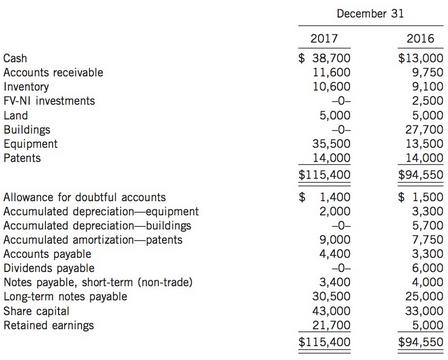Question
Seneca Corporation, which uses IFRS, has contracted with you to prepare a statement of cash flows. The controller has provided the following information: Additional information

Additional information related to 2017 is as follows:
1. Equipment that cost $10,500 and was 50% depreciated at the time of disposal was sold for $2,600.
2. Common shares were issued to pay $10,000 of the long-term note payable.
3. Cash dividends paid were $6,000. Seneca has adopted the policy of classifying dividends paid as operating activities.
4. On January 1, 2017, a flood destroyed the building. Insurance proceeds on the building were $23,000.
5. FV-NI investments in shares were sold at $3,300 above their cost. The fair value of these investments at December 31, 2016 equalled their original cost.
6. Cash of $17,000 was paid to acquire equipment.
7. A long-term note for $15,500 was issued in exchange for equipment.
8. Interest of $2,200 and income tax of $5,600 were paid in cash. Seneca has adopted the policy of classifying interest paid as financing activities.
Instructions
(a) Use the indirect method to analyze the above information and prepare a statement of cash flows for Seneca.
(b) Prepare a reconciliation of the change in the property, plant, and equipment's carrying amount to the amounts appearing on the statement of cash flows and corresponding notes.
(c) Financial statement preparers often use reconciliations of changes in major categories of statement of financial position accounts to balance the statement of cash flows, as required in part (b) above. What additional insight does this reconciliation reveal to a reader of the statement that is not as evident from the statement of cash flows?
(d) Prepare a short analysis of Seneca's cash flow activity for 2017. The analysis is to be given to the controller.
(e) What choices, if any, are available for classifications for interest and dividends paid or received by Seneca?
(f) What kind of company would you expect to be revealed by the operating, investing, and financing sections of Seneca's statement of cash flows: a company that is severely troubled financially or a recently formed company that is experiencing rapid growth?
(g) Compare Seneca's net cash flow provided by operating activities with profit. Comment on the relationship between these two amounts from the perspective of an investor.
December 31 2017 2016 $ 38,700 11,600 10,600 Cash $13,000 9,750 9,100 2,500 5,000 27,700 13,500 14,000 $94,550 Accounts receivable Inventory FV-NI investments -0- Land 5,000 -0- Buildings Equipment Patents 35,500 14,000 $115,400 $ 1,400 2,000 $ 1,500 Allowance for doubtful accounts Accumulated depreciation-equipment Accumulated depreciation-buildings Accumulated amortization-patents Accounts payable Dividends payable Notes payable, short-term (non-trade) Long-term notes payable Share capital Retained earnings 3,300 5,700 7,750 3,300 6,000 4,000 25,000 33,000 5,000 $94,550 -0- 9,000 4,400 -0- 3,400 30,500 43,000 21,700 $115,400
Step by Step Solution
3.41 Rating (160 Votes )
There are 3 Steps involved in it
Step: 1
Cash flow indirect method Cash flow from operating activities Net income before taxes 22700 Adjustme...
Get Instant Access to Expert-Tailored Solutions
See step-by-step solutions with expert insights and AI powered tools for academic success
Step: 2

Step: 3

Document Format ( 2 attachments)
635e2161d39e2_181696.pdf
180 KBs PDF File
635e2161d39e2_181696.docx
120 KBs Word File
Ace Your Homework with AI
Get the answers you need in no time with our AI-driven, step-by-step assistance
Get Started


